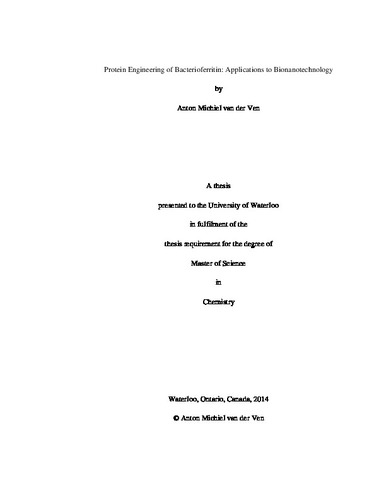| dc.description.abstract | Biological protein assemblies are the products of evolutionary necessity that have arisen to protect the cell, improve reaction rates, and/or compartmentalize biological systems. Belonging to this category of sel-assembling bionano-structures are cage proteins. Cage proteins are composed of multiple protomers (subunits) that self-assemble into many unique structures, all having interior, exterior, and interface surfaces available for controllable modification. Bacterioferritins (Bfr) are a set of cage proteins belonging to the ferritin superfamily of iron storage proteins, are roughly spherical with a 12 nm exterior diameter and an 8 nm interior diameter, are composed of 24 identical protomers, and contain 12 heme cofactors. An important feature of Bfr that was utilized for advancement in platform development was the locality of the N- and C- termini. These termini point towards the exterior and interior of the protein cage, which made them ideal for genetic engineering these two surfaces. Polyhistidine amino acid sequences (His6-tags) were added to the C-termini of the Bfr protein subunits in order to provide new selective affinity interactions on the interior protein surface of this multiprotein cavity. This His6-tag affinity interaction allowed for Ni2+-dependent complexation between the host Bfr and two guest molecules modified with a nitrilotriacetic (NTA) acid. The two proof of concept guests studied in our laboratory were streptavidin binding a biotin-XNTA functionality, and a gold nanoparticle (GNP) containing NTA functionalities. This approach was designed to make both streptavidin and GNPs addressable to the interior surface of Bfr through the NTA/His6-tag affinity interaction. The purpose of these experiments was to explore various methodologies to form controllable interactions between guest molecules and internal protein cavity surfaces. Additionally, the endogenous heme molecules were exchanged for fluorescently-modified hemes as a further approach to engineer this cage protein for host-guest interactions. The information gained from the above experiments will help develop the bionanotechnology applications of Bfr. | en |

